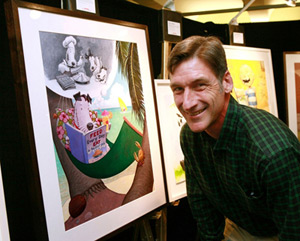Mark Teague, best-selling children’s author and illustrator of more than 40 books, including the now-classic How Do Dinosaurs Say Good Night?, is a doodler who credits his success to “dumb luck.”
But his fans know better.
Take the premise of Dear Mrs. LaRue: Letters from Obedience School, about a wirehaired terrier named Ike whose pranks prompt his owner to temporarily banish him to a “canine academy.”
In daily correspondence, Ike pleads with his owner for release: “You say I should be patient and accept that I’ll be here through the term. Are you aware that the term lasts TWO MONTHS? Do you know how long that is in dog years?”
Ike’s expressive language is matched by Teague’s irresistible illustrations, featuring lush, full-color renderings of daily life at the doggie spa, where white-jacketed waiters serve gourmet meals to pups seated at tables adorned with fresh flowers and white linens.
These images are juxtaposed with grim, black-and-white depictions of how Ike is experiencing his confinement. (On the book jacket, Ike warns readers not to be fooled by the cheery color pictures and to pay attention instead to the noir-esque portrayals of his suffering.)
“I was telling two different stories, and I had to make sure any kid could see a strong visual difference between what’s in Ike’s imagination and what’s really going on,” said Teague. The technique worked, and the illustrations resonate with readers of all ages.
Teague, 47, finds inspiration for his books in daily life. Dear Mrs. LaRue started out as a book of mournful letters written from summer camp by a homesick child. “But the story really wasn’t going anywhere until I started writing it from the dog’s perspective,” said Teague, who incorporated the antics of two beloved real-life dogs in the character of Ike. Since then, Teague has published three more books in the LaRue series: Detective LaRue, LaRue for Mayor, and LaRue Across America.
Teague has enjoyed steady success in the field of children’s publishing since shortly after graduating from UCSC with a degree in history in 1985. “I took courses with professors I liked, people like John Dizikes, Peter Kenez, and Gary Miles, more than by subject,” said Teague, who grew up in San Diego. “I don’t regret it. I read history all the time. Having that time to learn interesting things is really valuable.”
Teague wrote and illustrated his first children’s book, The Trouble with the Johnsons, while designing window displays for Barnes & Noble in New York City. “One of the editors who worked upstairs, where they had to wear suits, used to come downstairs to the art department and hang out, because we got to play loud music and have a good time,” recalled Teague. “He saw what I was working on and liked the book. That’s how I got my foot in the door. This is all dumb luck.”
That first book, published in 1989 about a homesick boy who returns home to find that (friendly) dinosaurs have moved in, earned Teague a spot in Publishers Weekly, where he was named one of 11 prominent new authors. It was the first of many hits, including Pigsty, about a kid whose room is so messy that pigs actually move in, Baby Tamer, inspired by the birth of his first daughter, Lily, and The Secret Shortcut, about two boys who are always late for school.
In addition to Teague’s solo author/illustrator ventures, his illustrations adorn the books of many acclaimed children’s authors, including Audrey Wood, Cynthia Rylant, and Jane Yolen.
The books with Yolen, How Do Dinosaurs Say Good Night? and How Do Dinosaurs Get Well Soon?, published in 2000 and 2002 by Scholastic Press, both became fixtures on the New York Times Best-seller List and brought Teague even greater recognition. (It was Teague’s idea to feature dinosaur children with human parents and to showcase different kinds of dinosaurs in these delightful tales of tantrums, bedtime stalling, sniffles, and fevers.)
“Overall, illustration is easier than writing,” said Teague, who uses acrylic gouache to create his fantasy worlds. “It’s kind of meditative. With writing, I really have to concentrate. But it’s very rewarding to me when a story comes together well.”
Teague’s studio is a converted room in the 19th-century Victorian home overlooking the Hudson River that he shares with his wife in Coxsackie, New York. His daughters, Lily and Ava, would sometimes join him, drawing at his side while he works.
He gets a lot of fan mail, including a request from a 10-year-old Cleveland boy to illustrate a story. “He wrote to me two years ago and asked me to illustrate it,” said Teague. “He’s got his own publication. I subscribe, actually. But he’s been talking with other writers since then. I don’t know if he’s going to be a writer, but he’ll probably rule the world.”
Teague has helped promote childhood literacy with the U.S. Department of Education’s Read*Write*Now program, and he occasionally visits schools to read books to children or attends a book signing. But for the most part, this hero of children’s literature leads a quiet life. “I guess this is what you do with a history degree,” he quipped.
Article by Jennifer McNulty


